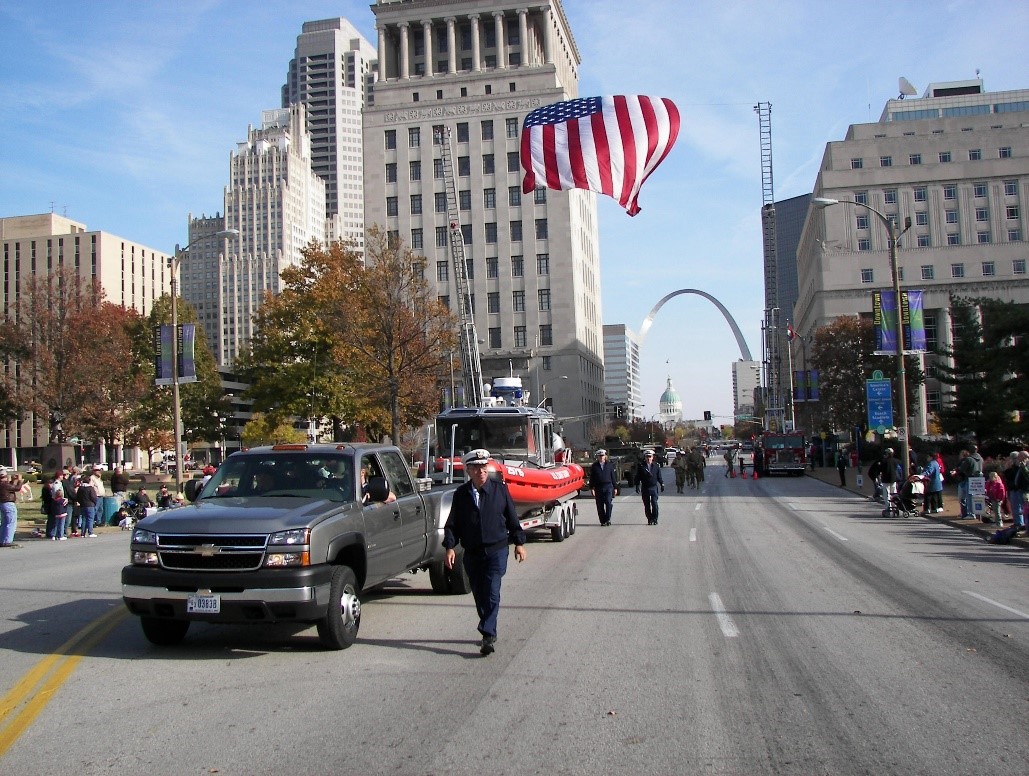Return to Flotilla 3-8's Home Page.

United States Coast Guard Auxiliary, Flotilla 38, Eighth St. Louis, St. Louis, MO, Division 3, 8th District Western Rivers
The United States Coast Guard Auxiliary is the uniformed civilian component of the Coast Guard established by Congress in 1939 to assist in promoting boating safety. It boasts nearly 30,000 members from all walks of life who receive special training so that they may be an integral part of Team Coast Guard. Auxiliarists assist the Coast Guard in non-law enforcement programs such as public education, vessel safety checks, safety patrols, search and rescue, marine environmental protection and Coast Guard Academy introduction programs for youth. Auxiliarists donate more than 2 million hours annually to benefit other boaters and their families.
Coast Guard Auxiliary District Eight, Western Region, Flotilla 38 is located in St. Louis County and has an area of responsibility (AOR) from the Alton Pool to the Mississippi River Front in St. Louis. Flotilla 38 routinely presents public safety classes, performs courtesy vessel safety checks (VSCs) , visits marine dealers, performs safety patrols afloat and ashore, augments active duty personnel where needed, and supports other missions as directed by the Commandant of the U.S. Coast Guard.OUR MISSION
ABOUT THE COAST GUARD
The Coast Guard is an armed maritime service with military, law enforcement, marine environmental protection, preventative safety and search-and-rescue (SAR) missions. In an average day, the Coast Guard conducts 109 SAR cases, saves 10 lives, assists 192 people in distress, protects $2.8 million in property, conducts 396 small boat patrols and 164 aircraft flights, boards 144 vessels and seizes 169 pounds of marijuana and 306 pounds of cocaine worth $9.6 million, interdict 14 illegal immigrants, process 238 merchant mariner licenses and documents, board 100 large vessels for port safety checks, responds to 20 oil or hazardous chemical spills totaling 2,800 gallons, services 135 buoys and other aids to navigation, safely conducts 2,509 vessels in and out of major ports, and its icebreakers assist 197,000 tons of shipping. Yet, interestingly enough, the Coast Guard maintains the same personnel levels as it did in 1967 and is smaller the New York City police department.
Formed as the Revenue Cutter Service in 1790 by Alexander Hamilton to collect taxes and deter piracy, the Coast Guard is the oldest armed, uniformed service in continual operation since 1790. (The Army, Navy and Marines were disbanded after the War for Independence and only later formed again; the Air Force was created in 1947.) In 1915, the federal lighthouse and lifesaving services were merged with the Revenue Cutter Service and renamed the Coast Guard. The Coast Guard was nominally under the administration of the Department of the Treasury (except during times of war, when it was under the Navy Department) until the 1960s, when it was transferred to the authority of the Department of Transportation. In March, 2003, the Coast Guard was transferred to the Department of Homeland Security.